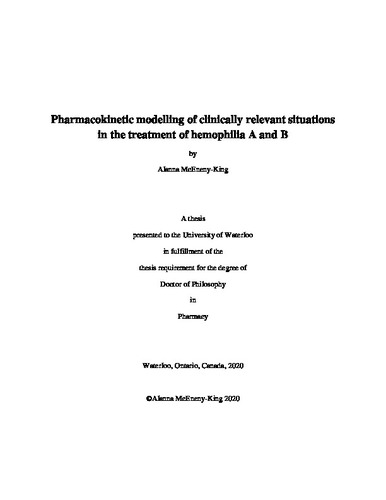| dc.description.abstract | Hemophilia is a congenital bleeding disorder caused by deficiency of clotting factor VIII (FVIII; hemophilia A) or IX (FIX; hemophilia B). Severe hemophilia patients have less than 1% (or 1 IU/dL) of normal factor activity, and often experience spontaneous bleeding episodes. This often occurs in the joints, causing devastating arthropathy later in life. The only proven method for preventing joint damage is the prophylactic administration of the appropriate clotting factor from a young age. However, prophylaxis with both FVIII and FIX is complicated by considerable between-subject variability in pharmacokinetic (PK) response. While a traditional PK study can be difficult to implement in routine care, a population pharmacokinetic (PopPK) approach – which reduces sampling burden and allows patients to forego a washout period – is more convenient for both patients and treatment providers. Nonetheless, PopPK can be challenging to implement due to a significant data requirement and a complicated process for model development and evaluation.
To overcome these barriers, the Web Accessible Population Pharmacokinetic Service for Hemophilia (WAPPS-Hemo) was launched in 2015. This service provides individual estimates of clinically relevant PK parameters (e.g. half-life, time to 1%, factor level at 72 hours post-infusion) from sparse patient samples and demographic data using Bayesian forecasting, with PopPK models serving as prior information. In order to meet its goals, the WAPPS-Hemo project requires a series of PopPK models that are valid for Bayesian estimation, for as many of the currently available factor concentrates as possible. In order to standardize the model building process, a data analysis protocol, outlining the steps of model development and evaluation and the criteria for decision-making, was established. This protocol was put into practice in the development of generic models for two classes of factor concentrate (standard half-life FVIII and standard half-life recombinant FIX). To date, the models described in this dissertation have been used to process over 2,000 PK requests on the WAPPS-Hemo platform.
In addition to developing models for use on the WAPPS-Hemo platform, the clinical factors impacting model performance were also investigated. Since Bayesian forecasting relies on only a few samples from the individual patient, the timing of these samples is of considerable importance. Limited sampling analyses were conducted to confirm that accurate estimates of relevant PK parameters can be obtained from a variety of limited sampling schemes. When sampling is extremely limited (e.g. collected from a single visit), estimation can be improved by incorporating knowledge of prior doses, and by conducting the PK study when samples are likely to still be quantifiable. Model performance is also dependent on the patient’s endogenous factor production, or baseline. In severe hemophilia patients, baseline factor activity may range from truly zero up to 1 IU/dL; however, baseline is often unknown as 1 IU/dL is typically the lower limit of quantification for both the one-stage clotting and chromogenic assays, forcing an assumption to be made. The consequences of these assumptions are highly variable; while baseline has little influence on the estimation of half-life, it makes a considerably difference when estimating time to 1% activity.
The models developed for this project have the potential for high impact with respect to the patient, who benefits from an individualized dosing regimen rather than a trial and error method, resulting in fewer adverse events and, in many cases, more cost-effective use of factor concentrates. The work presented in this dissertation also explores a variety of factors that impact model performance; this knowledge can be used by treatment providers to ensure they receive the most accurate estimates possible when utilizing the service. | en |

